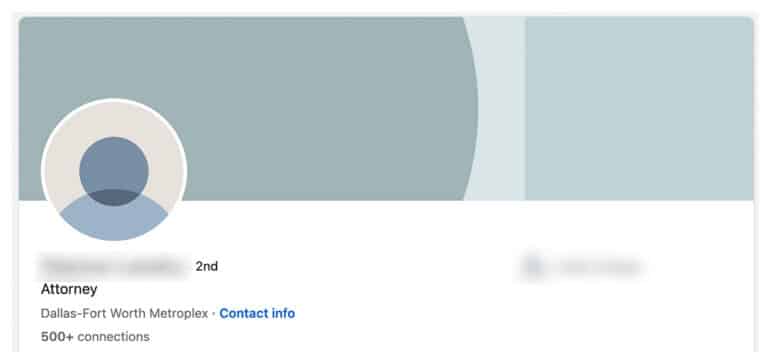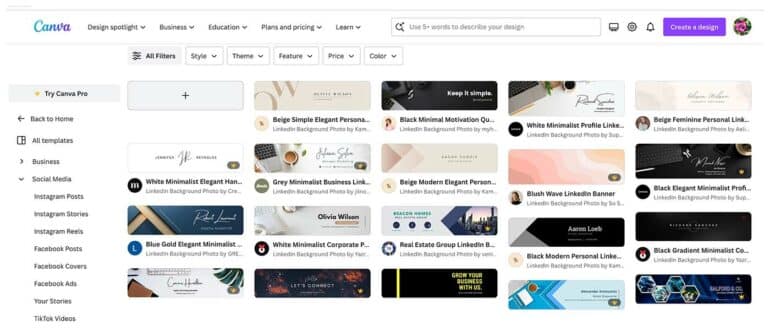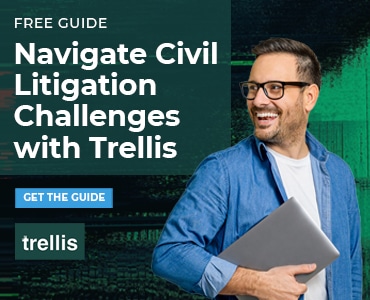Lawyers on LinkedIn don’t have to be influencers or even frequent posters for the platform to be a potent business development tool.

In kickoff meetings with new clients, most of them make a similar confession: “Just so you know,” they say, “I’m not good on LinkedIn.”
And when I check out their LinkedIn profiles, I discover that they are right.
Table of contents

An actual lawyer’s LinkedIn profile.
The Truth About LinkedIn
The truth is, most lawyers, most professionals of all stripes, aren’t very good on LinkedIn. We are, at best, C+ LinkedIn students. But, because the platform naturally elevates and amplifies all the A and B students, it can feel like “everybody is better at LinkedIn than I am.”
Here’s the good news: You don’t have to be a LinkedIn influencer or even a frequent poster for LinkedIn to be a potent business development tool.
In fact, I’ve all but stopped trying to convince my clients to regularly post on LinkedIn. That’s because lawyers tend to be overachieving perfectionists, and when an overachieving perfectionist can’t be perfect at something, they tend not to do it at all.
After all, who has time to live on social media when you have billable hours to tend to?
Why LinkedIn?
The key to turning your LinkedIn profile into an effective and passive supporter of your business development efforts is to take advantage of what LinkedIn offers that no other social media platform (that I know of) offers: a static profile that lets you essentially keep an updated online resume.
LinkedIn also holds immense credibility as a source of legal, business, and industry news, with 65% of C-suite and 57% of in-house counsel considering it credible, according to Greentarget’s 2022 digital and content marketing survey. Traditional media (e.g., The Wall Street Journal, New York Times, etc.) are 79% and 78%, respectively.
As anyone who’s tried to pitch a story to the Journal, the Times, or even your local newspaper can tell you, the barrier to entry for getting published in the traditional media is quite high. Whereas the barrier to getting published on LinkedIn is virtually non-existent.
Compared to traditional media, the ROI on LinkedIn is unbeatable.
Additionally, LinkedIn has such powerful search engine authority that if someone Googles you — which is what virtually anybody does once they’ve been referred to you — your LinkedIn profile is probably the top one or two search results they’ll see. So, if you want to make a great first impression on those prospective clients, your LinkedIn profile needs to be current, complete and compelling.
Once you’ve built out your profile and made it look snappy — which should only take an hour or two — all you need to do is keep it updated, which you can do annually, semi-annually, or at whatever interval works for you.
If you can do that, you’re doing better than the vast majority of LinkedIn users.
5 Tips for Beefing Up Your LinkedIn Profile
1. Professional Photo
A professional headshot significantly increases profile views. Avoid selfies or vacation pictures. If a professional photographer isn’t in your budget, try an AI photo generator such as Headshotpro.com.
2. Headline
Your headline (the line underneath your photo) should describe what you do and the services you provide, not just your job title (e.g., “Partner at Smith and Jones). Don’t overthink it. “Commercial Litigator” is better than “Attorney.” If you want to get a little more creative, feed your website bio into an AI assistant such as Bard or ChatGPT and ask it to suggest several possible LinkedIn headlines. Many will be cheesy and over-the-top, but it will give you something to work with.
3. Custom Banner Image
Rather than accept the default LinkedIn image above your photo, use Canva or similar design tools to create a banner that reflects your practice (e.g., oil wells or windmills for an energy lawyer), location (e.g., your city’s skyline), or your firm’s logo. Canva offers a “LinkedIn background photo template” that’s perfectly sized for LinkedIn’s banner.

4. Summary
Lead with your strengths and bona fides. Don’t make people hunt to find out what kind of law you practice. Don’t lead with your law school unless you’re a very recent grad. Should you just cut and paste your website bio? Not necessarily. Some lawyers like to use first person and a more personal tone on LinkedIn. If you want to use essentially the same content as your website bio but put it in first person or just make it sound different, an AI assistant can handle that task in seconds.
5. Profile Sections
LinkedIn offers numerous profile sections that most people ignore but that offer plenty of opportunities to showcase their experience.
- Link to your blog posts and published articles in “Publications”
- Add relevant legal work to “Projects”
- Keep your attorney recognitions updated in “Honors & Awards”
- Include your bar group activities in “Organizations”
- Showcase your outside interests and philanthropy in “Volunteer Work”
Once your profile is in shape, set a reminder to update it in 6 to 12 months.
Want to Get More Active on LinkedIn?
- If you’re looking to amp up your LinkedIn game, set a weekly reminder to log in and look around. Just lurk at first, but feel free to like, reshare and comment on posts.
- If you want to start making posts, then share your knowledge and advice; don’t just self-promote. Aim to become a source of genuine value. If others comment on your posts, respond to those comments. Use LinkedIn to build relationships, not just announce your news.
- Finally, focus on quality over quantity when it comes to making connections. Make it a habit to connect with those people you meet in real life, and always include a note with connection invites. Needless to say, don’t accept spam connection requests.
There’s No Need to Be an Influencer to “Be Good” at LinkedIn
With a few hours of up-front investment and periodic updates to your static profile, you’ll be making a solid first impression on anybody who’s looking you up online. Everything else is gravy.
Image © iStockPhoto.com.

Don’t miss out on our daily practice management tips. Subscribe to Attorney at Work’s free newsletter here >






















